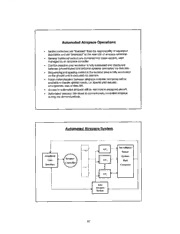
NASA Technical Reports Server (NTRS) 20010038377: A Vision of the Future ATM System PDF
Preview NASA Technical Reports Server (NTRS) 20010038377: A Vision of the Future ATM System
A Vision of the Future ATM System September 21, 2111111 | Dr.Heinz Erzberger Senior Scientist for ATM Ames Research Center Larqe Increases in Capacity, Safety and Efficiency Require a New Approach • Air trafficgrowth isincreasinglyconstrained bythecapacity limits of sectorized control, wherein a controller is responsible for separation assurance, planning, communications, coordination, etc. • Capacity gains through re-sectorization and sector size reduction have reached the point of diminishing retums. • Decision Support Tools provide modest gains but can't circumvent basic controller workload limits. • Constraints that limit flight efficiency can't be reduced at high traffic density because that would further exacerbate the controllers workload problem. • The inevitabilityof human error limitsfurther improvements in safety with current procedures. • Potential of reduced separation can't befully exploited because of workload and reaction time limits with controllers performing current duties. 85 Current ATM System Surveillance Voice Sensor | Graphical System, User Host Interface Computer Link I Support Tools I Decision t ATM Performance Gains Automated Airspace Reduced separation standards 50%- °s:,I CuiTerl| separation slandards Improved sensors '06 - q5 '15 -'25 86 Automated Airspace Operations • Sector controllers are "liberated" from the responsibilityofseparation assurance and are "promoted" to the new roleof airspace controller. • Several traditional sectors are combined into super-sectors, each managed by an airspace controller. • Conflict detection and resolution isfully automated and distributed between ground-based and airborne systems connected via data link. • Sequencing and spacing control inthe terminal area is fully automated on the ground and isexecuted via data link. • Voice communication between airspace controller and pilots will be available to handle special needs, i.e. special pilot request, emergencies, loss of data link. • Access to automated airspace will be restricted toequipped aircraft. • Automated airspace can revert to conventionally contTolled airspace during low demand periods. Automated Airspace Svstem 1 --g. Survet'llan ce Sensor Graphical System, i User Host Interface Computer .............. Aut'° Airspace System 87 Development Challenqes • Gaining acceptance of concept by operators, controllersand the public. • Design of systemarchitecture thathas multiplesafetynets to protect usersagainst varioustypes of failures. • Automated failuredetection and reconfigurationofsystem to operate inadegraded mode. • Roles and responsibilitiesofairspace controllers. • Design ofthe interface between airspace controllerand system element; retainingthe human-centered designwhile changing the roleofthe human. Development Challenges (cont.) • Transitioningfrom manual toautomated airspace operations. • Providing airspace and runway access for unequipped aircraft • Upgrading the CTAS algorithms and software to level of performance required for autonomous operation. • Establishing minimum equipment standards for airspace users. • Verification, validation and testing of concept. 88 Approaches to Automated ATC • Time-based (4D) Guidance • Self-Separation and advanced TCAS • Automated Airspace ime- aflce 89 Types of Automated Airspace • Self separation airspace • High altitude transition airspace: mixed climbing, descending and over-flights • Arrival and departure management airspace • Final approach sequencing and spacing airspace Fort Worth Center Traffic Flows FL240 and above 9O Automated Airspace Sectorization Fort Worth Center ArrivalOverflightDepaf_ure I t Automated Airspacefor DFW 440 450 460 470 480 490 500 91 Benefits of Super Sector ° Boundaries unconstrained by current center boundaries. • Elimination of trajectory constraints imposed by conventional sector structure and altitude stratification. • Reduction of handoff coordination. • Shared airspace for arrivals, departures and overflights allows flexibility in use of airspace and routes. • Unified airspace of super sectors enables increasing the range and effectiveness of conflict resolution. • Increased controller productivity. Steps Toward Automated Airspace • Complete deployment ofdecision supporttools for critical ATM specialties (2010). - DST technology is the foundation for Automated Airspace. • Introduce Distributed Air Ground procedures and improved sensors (2006). - When combined with DST's, this begins the process of changing sector controller roles and responsibilities. • Build high performance and secure air-ground data link required to support automated airspace operation (2012). • Evaluate prototype automated airspace system inselected high altitude airspace (2015). ° Install in high density on route airspace (2017). • Install in high density terminal areas (2020). 92
